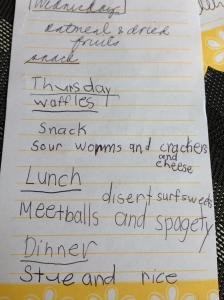Báon is a Tagalog word that means food, or items packed, specifically for a trip.
Ang báon ko ay tinapay. (I brought bread.) Nag-báon ako ng maraming libro. (I packed a lot of books.)
It can also mean monetary allowance for a trip.
Magkano ang báon mo? (How much money did you bring?)
Báon is also the word used to refer to food packed for school.
Anong gusto mong báon bukas? (What snack/lunch do you want to bring to school tomorrow?
I pack my children’s snacks and lunches for school. With the invention of Thermos and ice packs, there is really no reason for me to spend extra on hot lunches or salads at school.
Palagi silang may báon. (They always bring packed food.)
Occasionally, I would pre-order lunch for them in school, especially on sushi days. But regularly, nag ba-báon sila (they bring packed food).
My children know what to expect for their báon. I post the menu of the week on my refrigerator door for easy reference.
It is not always easy for me to follow through with my weekly menus, but when I do, I feel I am organized and in control. I have less food waste, I have more time to do other things, and I don’t overspend on food.
Planning our weekly menu is a family activity. My son would go through the recipe books I have, and then he would choose several dishes. Usually, I would be able to cook his choices.
 Bacon quiche from a recipe book
Bacon quiche from a recipe book
I would then buy all the ingredients and cook a week’s worth of food for báon and dinner. I would store them in leak-proof tempered glass containers so they can easily go in the microwave or oven.
My daughter would then decide on which days the food would be served. She would help write the menu.
Something could definitely be said when all you have to do is take a couple of containers from the fridge and dinner is served. You have more time to spend with the children.

 Adobo wings
Adobo wings Menu for this week
Menu for this week

